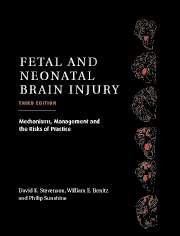Book contents
- Frontmatter
- Contents
- List of contributors
- Foreword
- Preface
- Part I Epidemiology, Pathophysiology, and Pathogenesis of Fetal and Neonatal Brain Injury
- Part II Pregnancy, Labor, and Delivery Complications Causing Brain Injury
- Part III Diagnosis of the Infant with Asphyxia
- Part IV Specific Conditions Associated with Fetal and Neonatal Brain Injury
- Part V Management of the Depressed or Neurologically Dysfunctional Neonate
- 34 Neonatal resuscitation: immediate management
- 35 Extended management
- 36 Neuroprotective mechanisms after hypoxic–ischemic injury
- 37 Neonatal seizures: an expression of fetal or neonatal brain disorders
- 38 Improving performance, reducing error, and minimizing risk in the delivery room
- 39 Nutritional support of the asphyxiated infant
- Part VI Assessing the Outcome of the Asphyxiated Infant
- Index
- Plate section
38 - Improving performance, reducing error, and minimizing risk in the delivery room
from Part V - Management of the Depressed or Neurologically Dysfunctional Neonate
Published online by Cambridge University Press: 10 November 2010
- Frontmatter
- Contents
- List of contributors
- Foreword
- Preface
- Part I Epidemiology, Pathophysiology, and Pathogenesis of Fetal and Neonatal Brain Injury
- Part II Pregnancy, Labor, and Delivery Complications Causing Brain Injury
- Part III Diagnosis of the Infant with Asphyxia
- Part IV Specific Conditions Associated with Fetal and Neonatal Brain Injury
- Part V Management of the Depressed or Neurologically Dysfunctional Neonate
- 34 Neonatal resuscitation: immediate management
- 35 Extended management
- 36 Neuroprotective mechanisms after hypoxic–ischemic injury
- 37 Neonatal seizures: an expression of fetal or neonatal brain disorders
- 38 Improving performance, reducing error, and minimizing risk in the delivery room
- 39 Nutritional support of the asphyxiated infant
- Part VI Assessing the Outcome of the Asphyxiated Infant
- Index
- Plate section
Summary
Introduction
In 1999 the Institute of Medicine published To Err is Human: Building a Safer Health System, a report on human error and patient safety in the USA. In this report the authors estimate that between 44,000 and 98,000 Americans die each year as a result of medical errors. Although this figure has been highly debated, it is based on extrapolation of the data contained in published studies out of Colorado, Utah, and New York. This figure is the equivalent of a large commercial airliner falling out of the sky every day. If the airline industry experienced that degree of failure, all flights would be voluntarily grounded until a thorough investigation revealed the causes and solutions were put into place. Yet medicine has yet to examine adequately the complex relationship among medical training, human performance, and medical errors.
While many factors influence the incidence of medical error in the USA today, this chapter will focus on training and education. Similarly, while medical errors occur across every medical specialty and affect all patients, this chapter will center on the newborn in the first minutes of life in the delivery room. First, the history of medical training will be reviewed. Next, new methodologies designed to improve the performance of professionals working in dynamic environments will be reviewed. Finally, the impediments to future enhancements of medical training and potential solutions to these will be discussed.
- Type
- Chapter
- Information
- Fetal and Neonatal Brain InjuryMechanisms, Management and the Risks of Practice, pp. 785 - 790Publisher: Cambridge University PressPrint publication year: 2003



